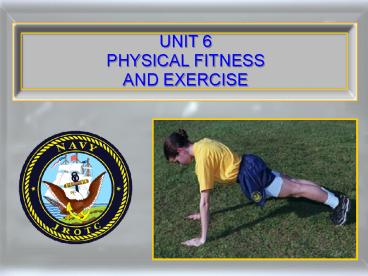Naval Science I_CadetFieldManual_Unit6 - PowerPoint PPT Presentation
1 / 33
Title: Naval Science I_CadetFieldManual_Unit6
1
UNIT 6 PHYSICAL FITNESS AND EXERCISE
2
Physical fitness relates to one who
exhibits vigor is active is skilled in some
physical activities enjoys a sense of well-being
3
To develop and maintain physical fitness
requires a lot of effort.
4
Results of Good Physical Fitness
Feeling good Looking good Being
healthy Enjoying life
5
Feeling Good
Regular exercise allows you to participate in
more activities and gives you the energy and
desire to do more than usual.
6
Looking Good Improves
Posture Fitness Confidence
Physical fitness helps you do this.
7
Physical Fitness - 11 Parts
Skill-related Speed Power Balance Coordination Re
action time Agility
Health-related Cardiovascular
fitness Strength Muscular endurance Flexibility B
ody fat
8
Cardiovascular Fitness
The ability to exercise the entire body
for long periods of time Requires a
strong heart, healthy lungs, and clear
blood vessels
9
Strength
The amount of force put forth with your
muscles Often associated with how much
weight you can lift
10
Muscular Endurance
The ability to use the muscles, which
are attached to the bone, many times
without tiring
11
Flexibility
The ability to use your joints fully
Fewer sore and injured muscles
12
Body Fat
The percentage of weight which is body
fat Increased body fat increased illness
13
Speed
The ability to perform a movement or cover
a distance in a short period of time
14
Power
The ability to do strength feats
quickly Involves both strength and
speed
15
Balance
The ability to keep upright while
standing still or moving
16
Coordination
The ability to use your senses, such as
your eyes, together with other body parts
or to use two or more parts of the body
together
17
Reaction Time
The amount of time it takes you to get
moving once you see the need for speed The
difference between winning and losing
18
Agility
The ability to change the position of
your body quickly and to control the
movement of your entire body
19
Principles of a Sound Exercise Program
1. The Principle of Overload 2. The Principle
of Progression 3. The Principle of Specificity
20
The Principle of Overload
Improve your fitness by doing more than
you normally do.
21
The Principle of Progression
Increase the amount of exercise you do over a
period of time.
22
The Principle of Specificity
Do specific exercises to build specific parts of
the body.
23
Threshold of Training
The minimum amount of exercise required to
build physical fitness You must exercise at
least at this level to build fitness. For best
results, you should exercise above the threshold
in the Fitness Target Zone.
24
Fitness Target Zone
For best results, you should exercise above the
threshold in the Fitness Target Zone. This zone
is made up of three parts
Intensity - how hard to work out
Frequency - how often to work out Duration
- how long to work out
25
Intensity
How hard you have to work for the
exercise to be effective
26
Frequency
How often you have to exercise
To be of benefit, you need to exercise at least
three times per week.
27
Duration
How long a work out should last to be
effective
Should last at least 15 to 30 minutes to
benefit your fitness
28
Cardiovascular Fitness
Fitness of the heart, lungs, blood, and
blood vessels Determined by your
aerobic heart rate
29
Aerobic Heart Rate
Resting Heart Rate
Aerobic Heart Rate
Beginner Regular
135-140 145-150 140-145 150-155 145-150
155-160
Less than 50 beats/min 51 - 70 beats/min 71 and
above beats/min
30
Determining Frequency Fitness Target Zone
At least three times a week
The best results may be gained from three to six
times per week.
31
Determining Duration
A minimum of 15 minutes to raise your
heart rate
Longer periods recommended
32
Cool-down
A short period after your workout during
which the body attempts to get "back to
normal" Should normally last at least 5
minutes
33
Heat Stress and Dehydration
To limit the effects of heat stress
and dehydration, you must replace the water that
is lost by the natural sweating that occurs under
normal nonphysical activities.































